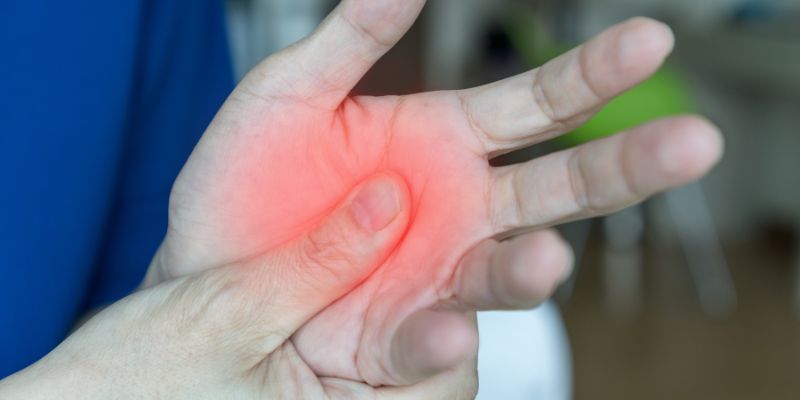Top 6 Common Causes of Myofascial Pain Syndrome You Should Know
Myofascial Pain Syndrome (MPS) is a chronic pain disorder, meaning it persists for more than three months, and the pain can be severe, aching in nature and widespread, and derived from Trigger Points or Taut Bands. Often it is quite disabling, causing pain and limiting mobility throughout the day. However, it is crucial to identify the primary causes of the syndrome since the conditions causing it can be numerous, although not all of them. These causes might be as diverse as physical exertion, repetitive motion traumas, mental burnout or correct posture violations
1. Muscle Overuse and Repetitive Strain

Muscle overuse and repetitive strain are among the leading causes of Myofascial Pain Syndrome (MPS). Repeated motions, such as typing, heavy lifting, or prolonged driving, can overwork specific muscle groups. Over time, this continuous strain can cause micro-tears in the muscle fibers, leading to the formation of trigger points and localized pain.
To prevent this, prioritize proper ergonomics, take frequent breaks during repetitive tasks, and incorporate stretching and strengthening exercises into your daily routine. These practices can help reduce strain and maintain muscle health.
2. Muscle Trauma or Injury
One of the most frequently reported causes for MPS is the acute muscle trauma or injury. Any physical injury, trauma or sports abrasion or any kind of falls causes local inflammation, injury to muscle fibres and thereby forms sensitive trigger points. These trigger points if not treated are likely to remain constant causes of pain within the human body.
To reduce the degrees of damage, cover the injured body part with cold pack for curing inflammation and, after relieving the agony make the injured explore gentle exercises. One cannot develop MPS after an injury if he/she seeks medical attention earliest.
3. Poor Posture
Poor posture is a leading cause of Myofascial Pain Syndrome (MPS). Spending long hours hunched over a desk, slouching on the couch, or holding awkward positions can place undue strain on specific muscle groups, particularly in the neck, shoulders, and lower back. Over time, this repeated strain disrupts the body’s natural alignment, leading to muscle imbalances. These imbalances often result in tightness, reduced flexibility, and the development of painful trigger points, making even basic movements uncomfortable.
To avoid posture-related MPS, it’s crucial to maintain a neutral spine and integrate ergonomic solutions into your daily routine. For example, use a chair with proper lumbar support, position your computer screen at eye level to prevent neck strain, and ensure your feet rest flat on the floor. Regularly checking your posture throughout the day can also help reinforce better habits. Additionally, taking short breaks to stretch and move around can relieve muscle tension caused by prolonged sitting.
4. Stress and Emotional Tension
Stress and emotional strain can be very injurious to health and regular show results in muscle rigidity and soreness. Some of the common signs that individuals are tense include developing a clenched jaw, rounded shoulders or tensed upper back. In the long run, stress maintains constant contraction of these muscles, depriving them of rich blood supply, which prolongs the formation of trigger points and development of chronic pain. If this cycle of stress and tension is not addressed MPS symptoms can become worse, physical condition can decline, and the emotional state is not going to help either.
In order to reduce stress effect on muscles it is essential to practice effective stress control strategies. These techniques for mindfulness such as mediation or deep breathing are helpful in lowering the activity of the nervous system and reducing pent up tension. Yoga and gentle stretching make the muscles more flexible and provide reduction of muscle tightness, and brisk walking or swimming decrease under strain breakout of stress hormones.
5. Insufficient Physical Activity
Physical inactivity is one of the causes of Myofascial Pain Syndrome (MPS). The muscles that have become dormant fail to contract, they harden and cause the organism to be less effective. They also reduce blood flow which is necessary in the transport of oxygen and nutrition to the muscles, the muscles functioning and recovery. This lack of movement leads to more tighten contracted muscle fibers that mean trigger points and chronic pain.
It is therefore important that an individual takes part in a regular exercise regime to avoid the MPS and in the process achieving a healthy muscle mass. Prolonged activity gradually aids in using correct posture, addressing muscle issues and reducing dangers of pain from inaction. For those who enter into exercising it is advisable to consult a physical therapist or a fitness expert in determination of right exercises.
6. Nutritional Deficiencies

Poor nutrition, particularly a lack of essential vitamins and minerals, can significantly impact muscle health and contribute to Myofascial Pain Syndrome (MPS). Muscles depend on a wide range of nutrients to function, repair, and recover. Deficiencies in key nutrients like Vitamin D, magnesium, and potassium can cause muscle cramps, stiffness, fatigue, and the formation of painful trigger points. Vitamin D aids in calcium absorption and muscle contraction, magnesium supports muscle relaxation and energy production, and potassium regulates muscle contractions and helps prevent spasms.
Maintaining a balanced diet that includes a variety of fruits, vegetables, lean proteins, healthy fats, and whole grains is essential for muscle health and overall well-being. Foods such as bananas, spinach, nuts, fish, and fortified dairy products are excellent sources of these critical nutrients.
Managing and Preventing Myofascial Pain Syndrome (MPS)
Here are some practical tips to support your muscle health:
- Stretch and Strengthen: Make stretching and strengthening exercises a regular part of your routine to enhance flexibility and build muscle resilience. Stretching helps prevent stiffness, while strengthening exercises provide crucial support for your joints and reduce the risk of injury. Dedicate just a few minutes each day to targeted exercises that focus on key muscle groups.
- Prioritize Ergonomics: Reduce muscle strain during work or daily tasks by using ergonomic furniture and tools. Ensure your desk and chair are properly adjusted to promote a healthy posture, and consider accessories like wrist supports or keyboard trays if you spend long hours typing. Small ergonomic adjustments can significantly alleviate chronic muscle discomfort.
- Hydration and Nutrition: Stay hydrated and nourish your body with a balanced, nutrient-rich diet to support muscle recovery and overall health. Proper hydration helps prevent cramps and flushes out toxins, while nutrients like protein, magnesium, and potassium are vital for muscle repair and strength. Incorporate foods such as lean proteins, nuts, leafy greens, and bananas into your meals to meet these needs.
- Seek Professional Guidance: Don’t ignore persistent muscle pain. If discomfort lasts more than a few days or worsens, consult a physical therapist or healthcare professional for an accurate diagnosis and tailored treatment plan. They can offer specialized exercises, manual therapies, and expert advice to effectively address the root causes of your muscle pain.
Conclusion
Myofascial Pain Syndrome, while potentially debilitating, can often be prevented and managed with the right approach. By understanding its causes, adopting healthy lifestyle habits, managing stress, and seeking timely medical care, individuals can significantly lower their risk of chronic pain. Take proactive steps to prioritize your muscle health and enjoy a pain-free, active life.












